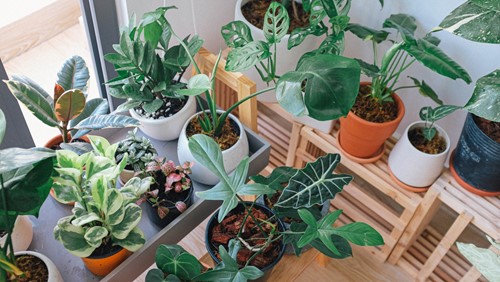
Plant owners have likely encountered the term "bottom watering" concerning houseplant care. The method works by watering your plants using the drainage hole at the bottom rather than pouring water in from the top. There are many benefits to bottom watering, but there are also some downsides worth considering. Here is a basic guide to the pros and cons of bottom-watering your plants:
Pros
Avoid Excess Surface Moisture
Some plants benefit from bottom watering because it keeps excess water away from the leaves. Succulents, for example, can wither or mildew if their leaves are exposed to water for too long. Other plants with tender foliage like inch plants and peperomias will also suffer if water is allowed to sit for too long on the leaves. Bottom-watering removes this issue entirely.
Strengthen Roots
Bottom watering can strengthen and encourage root growth. As the moisture saturates the soil through the bottom of the pot, the plant's roots will actively try to get to it. While a slow process, this "reaching" behavior can benefit the plant in the long term and speed up its growth.
Plants Control Their Intake
While it's still possible to overwater from the bottom, it's far less likely to happen as the plant will simply stop absorbing water when it's had enough to drink. The opposite is also true: an extremely dry and thirsty plant will absorb water quickly, which can tell you about its regular water needs.
Cons
Very Slow Process
Bottom-watering takes a long time. For a plant in a standard 6-inch growers pot, you may need to let it sit in water for over 30 minutes depending on the potting mix you use. Some plants are slow drinkers and require an hour or more for adequate watering.
Inconvenient in Small Spaces
You need shallow vessels for your plants to soak in, which can take up precious space. Some plant owners get around this problem by filling the kitchen sink or even the bathtub with water and placing several plants together at once. While efficient for the plants, it's inconvenient for the humans.
Bottom watering is a favorite method of many houseplant owners, but it's certainly not required. Consider these points when deciding how best to water your own plants.
About the Author

Bill Aibel
Bill joined the Cambridge office of Coldwell Banker in 2009. Since then he has had impressive results in residential and commercial real estate listings and sales. His work has earned him one of the company’s highest distinctions. As a Coldwell Banker Premier Agent, he has placed in the top 50 agents in the New England Region several years running.
